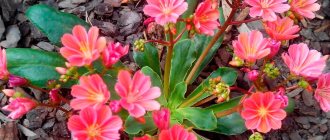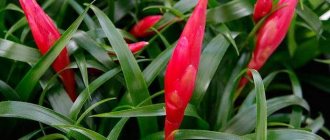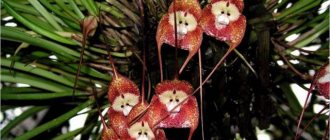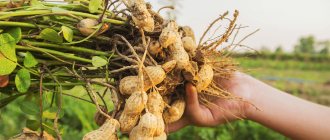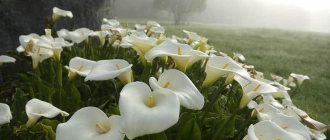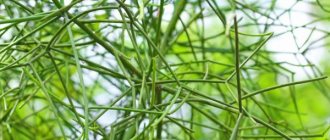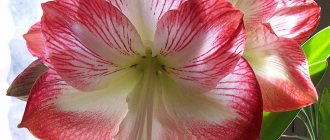Brugmansia
Brugmansia care at home will not burden you much, the main thing is to follow the recommendations of agricultural technicians. It is impossible to take your eyes off the plant during flowering, so mesmerizing are the flowers that strew the tree with multi-colored 20 cm gramophones. This tropical plant is not difficult to care for and has long won the love of gardeners. Brugmansia, very popular in Europe, has now begun to conquer Russian spaces. It is grown mainly as a potted or annual plant.
General information
The Datura flower produces flowers that are arranged vertically, while in Brugmansia they are lowered to the bottom.
The second name is also known, “Angel Trumpets”, which the plant received for its funnel-shaped flowers.
The flower contains a poisonous intoxicating substance; for safety, you need to take care of it with gloves.
The homeland of growth is warm subtropical countries, Southern Europe, South America. It is also well cultivated in the southern parts of Russia.
You can grow Brugmansia at home, placing a large pot on a warm terrace or balcony in the summer, and bringing it into a warm room for the winter.
- In the wild it reaches more than 2 meters in height. When grown in the garden, giving it more space, the bush will grow from 1.5-1.8 m in height and up to 2 m in width.
- It actively grows in the warm season.
- The bush is a perennial with a luxurious spreading crown. With large oval densely growing leaves.
- Huge bell flowers reach sizes up to half a meter in length. They come in various shades of red, white, orange, purple...
- Depending on the type, flowers are divided into simple, double and multi-level. Some species have a rich but pleasant aroma that spreads thickly in the evening.
- It blooms all summer until mid-autumn, and after flowering, in place of the flowers, a box with seeds is formed.
- The plant begins its growth from one trunk. Having reached a height of 100-150 cm, the first branch is formed and the trunk begins to branch.
Origin
Brugmansia, from the tropical and subtropical zones of America, in natural conditions the tree grows up to 5 meters in height; you must agree, the size is impressive. The plant belongs to the Solanaceae genus. Prefers a humid climate, grows along river banks, in foothills and hilly areas.
Beautiful flowers adorn the rather large shrub; they can be of different colors, yellow and hot pink, white and orange. The aroma of flowers is simply intoxicating.
In central Russia, the shrub should be grown in a container; it will freeze in the ground; lowering the temperature to +3ºC for a seedling is already fatal. What to do, Tropicana.
Types of Brugmansia with photos and names
The following types are used in indoor floriculture:
Brugmansia sanguinea
A distinctive feature of the species are orange-red flowers with yellow veins, which have absolutely no aroma. At prolonged temperatures above +25°, the plant refuses to bloom. Under natural conditions, the species is distributed in Chile and Ecuador.
Brugmansia snow-white Brugmansia candida
The flowers are tubular in shape and have a strong scent in the evening. Their color, depending on the variety, can be white, pink or yellow. The leaves are oval-shaped, slightly pubescent, on long petioles. The species lays buds only after differences between day and night temperatures.
Brugmansia suaveolens
The species is native to eastern Brazil. In nature it grows as trees up to 5 meters high. Flowers are white or pink, up to 30 cm long.
Golden Brugmansia (Brugmansia aurea)
Tall, large plants with yellow flowers. The flowers have a characteristic outward bend. The species is native to northern Colombia.
Types and varieties. Photo
The genus Brugmansia belongs to the nightshade family and has few natural varieties. It’s worth getting acquainted with them, you will find out how they can winter in Russia, under extreme conditions for the plant.
Firstly, it should be warned that the shrub can only survive the winter indoors. The best option is a greenhouse, or an insulated veranda, where the air temperature does not drop below +10°C. Alternatively, you can grow the plant as an annual shrub through seedlings.
Meet them:
- B.aurea.
- B. suaveolens.
- B. sanguinea.
- B. versicolor.
- B. arborea.
- B. vulcanicola.
The plant also has varieties with double flowers. Brugmansia flowers are arranged with the gramophones downwards, do not confuse them with Datura, they grow upwards.
Unfortunately, there are few suitable varieties for cultivation in Russia. The spread of this magnificent plant is hampered by sub-zero temperatures throughout almost the entire country. The permissible temperature at which the plant can exist is not lower than +5-+8°C, just below this mark on the thermometer, the green mass of Brugmansia dies.
Brugmansia care at home
Location and lighting
In Russia, Brugmansia is grown as an exotic indoor or greenhouse plant with large drooping flowers and exuding a delicate aroma. When kept indoors, this flower does not shed its leaves. Prefers good lighting, direct sunlight. The tree is moisture-loving and requires sufficiently moist soil and air.
In winter, it only partially sheds its leaves. In summer, the flower can be grown on the balcony, but it should be on the east or west side. The optimal temperature for the plant is from +13 to +26°C, on glazed balconies and loggias, it will simply burn.
There, in sunlight, with the window sashes open, the temperature reaches +54. Brugmansia requires only a few hours of bright light, and the rest of the time it will be satisfied with light partial shade.
During the off-season, the plant needs additional lighting. This is a long-day flower; at this time it lacks several hours of natural light.
Of course, if you live in a country house or a warm dacha, you can grow such a flower in your garden, but also as a potted plant. The tree loves free air, a lot of light and space.
Unfortunately, our climate is not suitable for growing tropical flowers in open ground. Only on the southern coast of Crimea is it grown in the ground, and not always successfully.
Brugmansia does not like wind; young tender and fragile shoots break in strong gusts. Yes, the shoots, heavy from the many large flowers, require additional support. Otherwise, they may break under the weight of this amazing beauty.
The plant has a large area of evaporation. Its decorative, large succulent leaves require additional spraying for watering.
Watering
Shrubs located on a personal plot require daily watering. If the plant does not get enough moisture, it will begin to shed leaves and flowers. In the summer, Brugmansia begins to grow intensively and throw out young shoots, consuming a lot of water. At this time, do not be lazy and spray 2-3 per day. In inclement weather, water only when the top layer of soil dries out.
In winter, reduce watering by 2 times, the plant continues to grow, it is necessary to slow down the growing season. Try to send Brugmansia into hibernation. Providing appropriate temperature and light conditions. If you do not plan to slow down growth, then continue to moisten the plant in summer mode. Don't forget to ensure indoor humidity is up to 75%.
Reproduction methods
Brungmansia is propagated mainly by cuttings, but sometimes seeds are also used.
Cuttings
Propagation by cuttings is used in autumn or spring:
- Young but lignified stems with a growing point, with 2-3 buds, are cut off, the leaves are removed.
- Take an opaque container, pour water with soluble coal, and place the planting material.
- They create illumination and temperature - +20 °C.
- When roots appear (2 weeks), plant them in separate pots.
- The soil is loose, breathable, consisting of peat, perlite, sand 2:1:1.
Seeds
Growing from seeds is a difficult and long process, and the properties of the variety may not be preserved.
- Planted in the first months of winter or early spring.
- For better germination, the seeds are kept in Kornevin.
- Take a container with light soil, distribute planting material there, deepening it by 0.5-1 mm, and moisten it.
- Cover with a transparent lid (glass, polyethylene).
- Provide +20…+25 °C, good lighting.
- After the emergence of shoots, the film is removed after 2 weeks.
- The crops are sprayed with settled warm water at least 2 times a day, being careful not to overwater.
- When the fifth leaf appears, the seedlings are planted.
Transplantation and substrate
Before planting the plant, you need to prepare the appropriate substrate. Each species has its own. The flower loves nutritious soil consisting of loam and humus; a drainage layer must be laid.
In estates where there are domestic animals, such as rabbits, goats, cows, Brugmansia is planted to camouflage the manure heap (it needs to be stored somewhere). It grows well there, and it eliminates the unpleasant smell, and the appearance of the yard looks well-groomed.
Before transplanting into a larger container or into the soil, Brugmansia branches should be trimmed, do not overdo it, and do not cut too much. Flower buds are located on the branches; if you prune too hard, you will remove most of the future flowers.
Transfer the plant to a new container or prepared planting hole. Add soil to the full volume, water it, let Brugmansia grow and become prettier.
Bloom
In a warm indoor climate, the flower feels quite comfortable, it’s a pity that it takes up a lot of space. Indeed, already in the first year, under favorable growing conditions, it reaches almost a meter in height. If the bush grows at room temperature, somewhere in the range of +21-+25°C, then its lighting should match the intensity of a summer sunny day, and the humidity in the room should be about 60%-70%.
Another component of intense and long flowering is very frequent feeding, every week or more often, maybe every 5 days. The plant is powerful, grows quickly, like all accelerators, and loves to eat.
Where to store Brugmansia in winter?
It is best to place a flowerpot in a cool room (insulated balcony or veranda) with moderate lighting.
Before bringing the bucket into the house, you need to give the bush a chance to acclimatize and the cut areas to heal. To do this, the flower is left outside for a couple of days.
The comfortable temperature for Brugmansia in winter is 12-15 degrees Celsius. Water it at this time should be moderate and infrequent.
Features of preparing Brugmansia growing in the garden for wintering - video
How to make a plant bloom in winter
The Russian climate is not suitable for year-round soil cultivation of Brugmansia. In autumn, when the air temperature drops to +5 at night, it is time to transport it to a room with appropriate conditions for wintering. You need to immediately draw a conclusion for yourself. Do you want the bush to continue to bloom? Or do you leave it at rest for a while?
We decided to continue admiring the wild flowering of the bush. This means that at home, provide the plant with good fertilizing, preferably organic matter, every week, or phosphorus-potassium fertilizers, also weekly, and exclude nitrogen during the winter months. So as not to provoke violent growth of branches and leaves.
It is better to dilute fertilizers in water and water them with this mixture, so they are better absorbed by Brugmansia. About the concentration of fertilizers for watering a flower, it is best to consult with agricultural technicians; they will give a more accurate answer to the question asked.
Description of the plant
It’s worth starting the story about this plant with the history of its origin. The fact is that it has been known since ancient times. And then it attracted many sorcerers, shamans and magicians who actively used the properties of flowers. Tinctures, potions and other drugs were prepared from them. The plant was believed to have truly magical properties. And that with its help you can not only achieve what you want, but also bewitch anyone.
And there really is a grain of truth in this. The fact is that the plant has intoxicating properties. Therefore, the effect of its impact on the human body is obvious. In addition, Brugmansia can become a strong poison. This quality was also, of course, used in ancient times.
South America is considered to be the birthplace of the plant. It was there that the first mention of Brugmansia appeared. It was described in written sources dating back to the 17th century. And only at the beginning of the 18th century the first mention of the tree-like plant Brugmansia appeared. It is noteworthy that the flower received its name around the same time. They named it in honor of a Dutch historian whose name was Sebald Brugmans.
In nature, Brugmansia grows in small groups. The plant belongs to the Solanaceae family. And initially, the flowers and other parts of the plant contained many substances related to psychoactive compounds. That is why the plant is classified in the genus Datura, or Datura.
Usually at home the height of the bush does not exceed two meters. Although in nature the plant can be several times taller. And although the development of the shrub occurs quite quickly, the lignification of branches and shoots proceeds rather slowly. The root system is powerful, strong and strong. It goes very deep into the ground and at the same time it is quite wide. The plant branches quite actively, which is why it needs to be pruned regularly to form a beautiful crown.
The leaves of the flower are smooth, but with slight pubescence in the very center. Brugmansia is especially beautiful during the flowering period. Its flowers are large and tubular in shape, which is why they are often called “the trumpets of the archangels.” The flowers hang down like drooping bells after a thunderstorm. But at the same time, each flower is quite large. So, the diameter, on average, is about 15 centimeters. And the length can reach 25 centimeters!
It is important to remember that Brugmansia will begin to bloom only when its entire above-ground part is fully formed. Moreover, during the entire season the plant will bloom more than once or even twice. It blooms magnificently and very beautifully. The aroma of the flowers is very bright and even persistent. but it is fully revealed only in the late evening and at night.
Winter care
A plant preparing for a dormant period is stopped feeding, watering is reduced, and of course, according to the rules, it is placed in a dark room, but anyone who has been growing Brugmansia for a long time is advised to place it in a bright room with a temperature of +10°C.
They convince you that the flower likes it better and begins to grow, on time, without your intervention. Do not stop watering during this time, but reduce it significantly. The lump of earth should be slightly moist all the time to prevent acidification of the soil.
Brugmansia wintering
Winter care involves insulation, since Brungmansia is afraid of frost and is brought indoors. In this case, it can continue to bloom. The dormant period of this species is not clearly defined, so if the conditions are comfortable, the flowering will probably last throughout the winter. For example, additional lighting will be needed, since it gets dark earlier in winter.
The watering mode can be maintained if you maintain a comfortable room temperature. If the room temperature is low (5-10°C), then watering should be reduced. If the lighting is dim, then most likely the leaves will fall off, but closer to spring new buds will begin to appear and additional lighting will be required.
Trimming
Proper pruning is the key to prolific flowering of the tropicana. It is done according to existing laws:
- Pruning should be done in February, early March, no later.
- Be sure to leave Y-forks when pruning.
- A seedling grown from cuttings or seeds should have several forks in its second year of growth.
- At the beginning of their development, these seedlings do not have an upper growth point; the first pruning is carried out only after the initial flowering.
- Pruning is carried out while preserving smaller, gnarled, side branches; they can be shortened only by a third.
- Formative pruning is done to slow down the growth of the plant.
Reproduction of Brugmansia
Brugmansia reproduces in several ways:
- cuttings;
- air layering;
- seeds.
It's done like this. Air layering - a well-developed shoot of one-year-olds is taken and a wedge-shaped incision is made on it. Do not overdo it, its depth is no more than the trunk. Sprinkle the cut with rootite and wrap it in wet sphagnum. Place a polyethylene sleeve over the cut area and secure it with rubber bands at both ends. If the branch sags a lot, place supports under it.
Now all that remains is to wait for the roots to appear; make sure that the moss is kept moist all the time. When dry, moisten with a syringe. Rooting will occur in 1-1.5 months.
Cuttings - when pruning, a lot of cut branches are formed, so they are suitable for preparing cuttings. The best branches for cuttings are branches that have a knot with a branch; cut off all the leaves.
Sprinkle the end of the cutting with root and place it in moist soil or water. Roots will soon appear from the white cones that appear on the stem. Transplant the cuttings with roots into the ground and begin to harden.
Sowing with seeds - material not treated with growth stimulants, germinates in 1-2 months. So, it is better to treat with root, the seeds will germinate much faster. These seedlings will bloom next year.
Growing Brugmansia from seeds
Brugmansia can be propagated by sowing seeds. It should be borne in mind that varietal characteristics will only be partially preserved. For sowing, prepare a light, moisture-intensive substrate from equal parts of peat, sand and perlite. The seeds are planted to a depth of no more than 1 cm. To create increased humidity, the container is covered with a piece of glass or film.
As soon as the first shoots appear, they are immediately removed. After the development of 3-4 true leaves, the seedlings are transplanted into separate containers. The main disadvantage of seed propagation is the long cultivation time. It takes 2-3 years from sowing to flowering.
Diseases and pests
The spider mite has an incomprehensible liking for Brugmansia. As a rule, he attacks her in closed, dry rooms. Therefore, preventive spraying of the plant with appropriate preparations should be carried out regularly.
The invader settles in and begins to weave a web from the inside of the leaf. Be extremely careful when processing the plant so as not to miss an infected leaf. Treatment is carried out with Bio Insect, Plant Spray.
When grown in a garden plot, the plant is constantly attacked by slugs and caterpillars. Although the bush is poisonous, they still eat flowers and leaves, disfiguring this beautiful flower.
Problems during cultivation
Problems can probably arise when growing any plant. Brugmansia is no exception. Even with ideal care, sometimes diseases and seedling death occur.
Most often, when growing this exotic from the tropics, there is a problem with flowering. Quite often one hears the question of why it doesn’t bloom or produce seeds.
It is possible that the flowering age has not yet arrived or that the conditions created for this are not appropriate. Either there is not enough light, or maybe the air is dry or the food is poor. In order for a flower to bloom, it needs enhanced nutrition, preferably potassium-phosphorus fertilizers. They stimulate the flowering of the plant.
The leaves turn yellow and fall off, because there is some reason. Perhaps the reason is lack of lighting or low air temperature. It seems like little things, but the plant suffers.
Just be more careful when caring for your pets.
Problems of caring for Brugmansia in open ground
Why do Brugmansia leaves turn yellow and fall off?
- Leaves turn yellow and fall off - this is considered one of the important problems of the crop. There may be several reasons:
- Acclimatization. During the first time after planting, the leaves turn yellow and fall off. The plant sheds them due to accelerated growth and lack of microelements to nourish the foliage. The process will stop after the root grows.
- Not enough nitrogen . The plant requires regular nutrition, so it should not be planted in poor soil.
- Brugmansia is a tree-like plant. The lower leaves fall off, and a new shoot is formed at the growth point, sometimes immediately with buds.
- Dry air or lack of moisture. The plant needs frequent watering, but without conserving water. It is important to carry out drainage at the bottom of the planting hole, loosening, and mulching with plant debris.
After determining the cause, it is necessary to reconsider the conditions for caring for the plant. When keeping the bush in a container, it is recommended to increase the volume to 20 liters. To improve the soil structure in the summer, you need to frequently use organic fertilizers.
Why do Brugmansia leaves curl?
- The problem of leaf curling occurs when Brugmansia is exposed to spider mites. The pest pierces the edges of the leaves, which disrupts the biological processes in this area of the leaf. It is necessary to provide more light, it is advisable to reduce the temperature to cool, at least until the time when the day noticeably increases. Also, pest control should be carried out.
Why do Brugmansia branches dry out?
- If the functionality of the root system is impaired, nutrients do not reach the upper part of the plant, which leads to dry branches. This is often due to increased soil moisture. You can save the crop at the initial stage using a fertilizer solution.
Why doesn't Brugmansia bloom?
- Plants usually bloom in the 3rd year after planting. The reason may be a lack of lighting, so the shoots grow long and weak. With insufficient watering, the earthen ball dries out, which leads to the dropping of buds. Brugmansia - tree-like can bloom only after the visible part is fully formed.
Forums and reviews
On one of the forums, its participants are concerned about why Brugmansia has no seeds. Forum member Marusya believes that the flower simply has not yet reached the time to form seeds.
Another question is whether it is worth sending the plant into hibernation. Last year the bush overwintered poorly, I had to re-root it in the summer, so I don’t know whether to force it to bloom or send it into hibernation, although the leaves are green and are not going to fall off. Please advise!
And I’m concerned about the size of the plant, what can be done so that Brugmansia doesn’t take up so much space in the room. Safi has not yet answered this question.
Brugmansia is a beautiful plant and not so difficult to care for. Of course, in our northern country, it is better to grow it as a potted plant. Don’t be afraid of caring for Brugmansia at home, you’ll see that it will thank you for your care with gorgeous blooms.
Brugmansia in the spring, what time to plant in the garden
Brugmansia is a heat-loving tree-like shrub. It is recommended to plant it in the garden in the spring after all spring frosts, otherwise the plant will die.
When planting Brugmansia in open ground, you need to take into account all its preferences. The landing site should be warm, well lit and protected from winds and drafts. Only in this case will Brugmansia delight you with abundant flowering.

